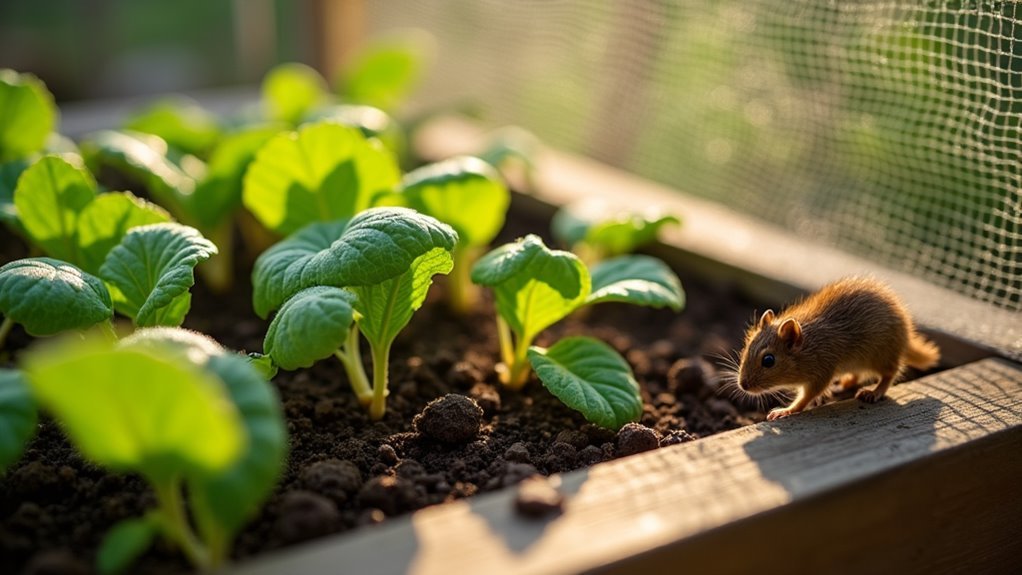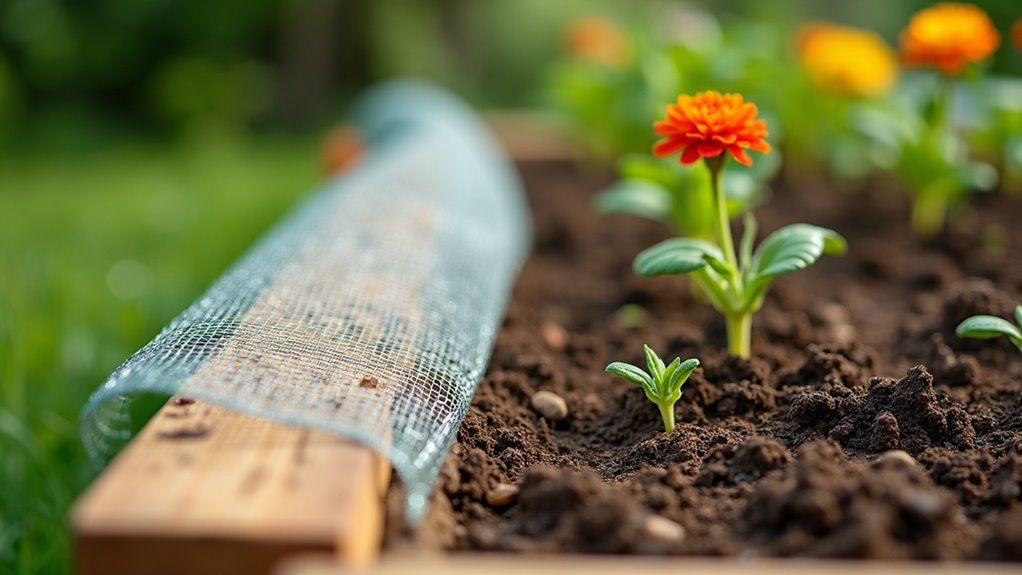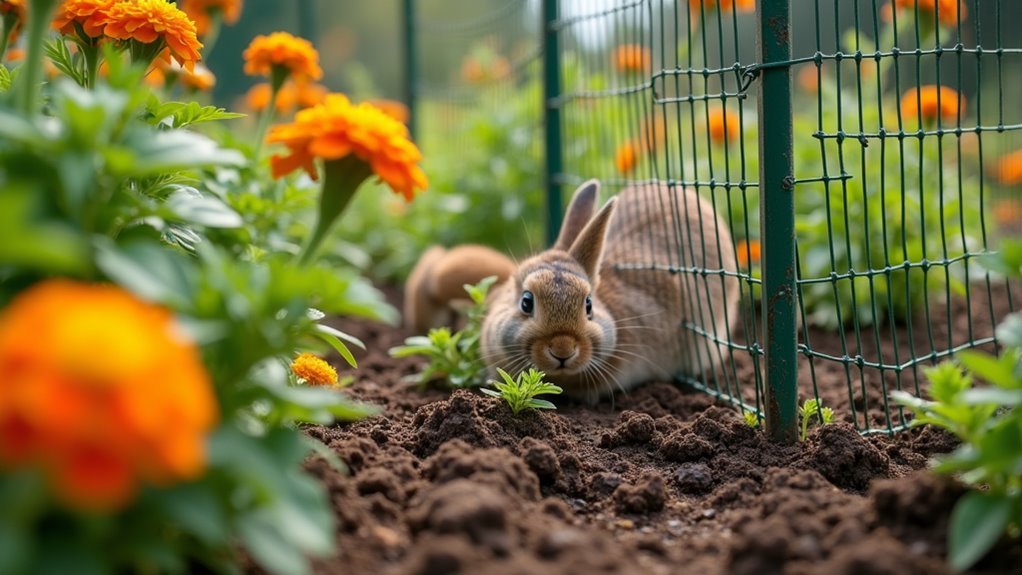Your raised bed garden’s elevated structure and accessible design make it a prime target for numerous pests including gophers, rabbits, cats, deer, and raccoons. Without proper barriers, these animals can easily access your plants through open bottoms, unprotected sides, or by burrowing underneath. The raised design actually signals to wildlife that food sources are readily available, making your garden more vulnerable than ground-level plots. Understanding these specific risks will help you implement the most effective protection strategies.
Understanding the Vulnerability of Raised Bed Gardens

While raised bed gardens offer numerous advantages like improved drainage and easier access, they’re surprisingly vulnerable to pest intrusions that many gardeners don’t anticipate.
Your elevated garden area attracts various animal pests including gophers, rabbits, cats, deer, and raccoons. Without proper protective measures, these creatures easily access your raised beds from below through open bottoms or climb over the sides.
Burrowing pests infiltrate through unprotected soil, while larger animals view elevated structures as accessible food sources.
You’ll need physical barriers like hardware cloth installed at the bottom and sides to prevent underground entry. Regular monitoring becomes essential since any breach in your defenses allows rapid pest invasions that threaten plant health and garden productivity.
Essential Materials for Effective Pest Barriers
Creating effective pest barriers starts with selecting the right materials that’ll withstand years of underground conditions and determined animal intrusions.
You’ll want hardware cloth with one-inch or two-inch mesh rather than chicken wire, as it offers superior durability and smaller openings that effectively block burrowing pests like gophers and voles.
For your raised beds, install barriers at least one foot deep to prevent underground access. A solid base beneath your garden beds adds another layer of protection against ground-dwelling invaders.
Quality hardware cloth provides 20-30 years of reliable service when properly installed. Remember to monitor for wear regularly and guarantee secure installation throughout the barrier’s lifespan to maintain maximum protection for your plants.
Proper Installation Techniques for Hardware Cloth

Since hardware cloth forms the foundation of your pest barrier system, proper installation determines whether your raised beds will successfully protect your plants or become an expensive failure.
Proper hardware cloth installation makes the difference between a thriving garden sanctuary and a costly pest-feeding ground.
Follow these essential installation techniques to create impenetrable pest barriers against burrowing pests.
Critical Installation Steps:
- Build upside down – Construct your raised beds inverted to easily secure hardware cloth with nails or staples before flipping over.
- Choose proper mesh – Use one or two-inch mesh hardware cloth for ideal protection against gophers and underground invaders.
- Bury deeply – Extend hardware cloth at least one foot into the ground beneath your raised beds.
Once you’ve filled the beds with soil, establish a regular maintenance schedule.
Inspect your hardware cloth quarterly for wear or damage to guarantee long-term effectiveness of your pest barrier investment.
Protecting Against Burrowing Pests Like Gophers and Moles
Although hardware cloth provides your primary defense line, understanding the specific behaviors of gophers and moles helps you target your protection strategies more effectively.
These burrowing pests can devastate your raised beds by attacking plant root systems and destabilizing soil structure. You’ll spot gopher activity through fresh mounds of loose earth appearing on your garden surface.
Since gopher invasions often occur in cycles, you can’t rely on one-time installations alone. Regular inspection of your barriers guarantees they’re working properly.
The hardware cloth’s 20-30 year underground lifespan makes it superior to other materials for long-term protection.
Combining solid bases with properly installed barriers creates an impenetrable defense system that keeps these destructive pests away from your plants.
Deterring Surface Pests and Small Animals

While underground barriers protect against burrowing invaders, surface-level threats require different defensive strategies to keep your raised beds thriving.
Your elevated garden design naturally creates barriers against slugs and snails, making it harder for these surface pests to reach your plants. However, small animals like rabbits, chipmunks, and cats need additional deterrents.
You’ll want to implement these protective measures:
- Install hardware cloth around your raised beds’ perimeter to block rabbits and chipmunks.
- Add prickly surfaces or chicken wire on top to discourage cats from scratching soil.
- Use livestock panels to create unwelcoming environments for persistent garden pests.
Regular monitoring and maintenance guarantee your pest barriers remain effective against these determined invaders.
Without proper upkeep, wear and tear compromises your defenses.
Choosing the Right Barrier Height and Coverage
Strategic barrier dimensions form the foundation of effective pest protection for your raised garden beds. You’ll need to take into account both height and coverage to create extensive protection against various pests.
| Pest Type | Minimum Height | Coverage Requirements |
|---|---|---|
| Rabbits/Small Rodents | 12-18 inches | Full perimeter with soil barriers |
| Deer/Large Animals | 36+ inches | Complete vertical enclosure |
| Burrowing Pests | Ground level | Hardware cloth 12+ inches underground |
| Climbing Animals | 36+ inches | Enclosed top and sides |
Your barriers must cover the entire perimeter without gaps to prevent pests from slipping through. Install hardware cloth or gopher wire around the base, extending at least 12 inches into the soil. For maximum protection, create vertical extensions above your raised beds to deter climbing pests and larger animals from accessing your plants.
Maintenance and Long-Term Barrier Effectiveness
Once your pest barriers are properly installed, you’ll need to establish a regular maintenance routine to preserve their protective capabilities.
Quality hardware cloth can provide 20-30 years of underground protection in raised beds, but only with proper monitoring and care.
Your maintenance schedule should include:
- Monthly inspections – Check for signs of damage, wear, or pest activity around barrier edges.
- Annual assessments – Examine the integrity of underground sections and verify depth remains adequate.
- Immediate repairs – Address any compromised areas to prevent pests from exploiting weaknesses.
Regular monitoring guarantees your barriers maintain their effectiveness against burrowing pests like gophers and voles.
Pay special attention to corners and joints where damage commonly occurs, as these vulnerable spots can compromise your entire protection system.
Cost-Effective Alternatives to Traditional Pest Barriers
Budget-conscious gardeners can achieve effective pest protection without breaking the bank by exploring creative alternatives to expensive commercial barriers. You’ll find that homemade barriers using repurposed materials offer excellent protection while keeping costs minimal.
| Alternative Material | Primary Benefit |
|---|---|
| Old window screens | Effective small pest deterrent |
| Hardware cloth | Durable 20-30 year lifespan |
| Reclaimed wood edges | Natural climbing pest prevention |
| Strong-smelling herbs | Natural deterrents without barriers |
Installing a weed barrier at the bottom of your raised beds greatly reduces maintenance costs. You can create cost-effective solutions by combining organic materials with strategic design elements like smooth sides and flat ledges that naturally deter climbing pests, eliminating the need for additional physical barriers.
Frequently Asked Questions
Should I Put a Barrier Under My Raised Garden Bed?
You should install a barrier under your raised garden bed to protect plants from gophers, moles, and voles. Use hardware cloth buried one foot deep for twenty to thirty years of effective pest control.
How to Protect Raised Beds From Animals?
You’ll need 36-inch tall beds with hardware cloth on bottom and sides. Add chicken wire on soil surface for cats, use floating row covers for birds, and inspect regularly for barrier breaches.
Can Groundhogs Get in Raised Beds?
Yes, groundhogs can easily get into raised beds by digging underneath them. You’ll need to install hardware cloth at least one foot deep beneath your beds to prevent their powerful claws from accessing your plants.
How to Protect Raised Garden Beds From Bugs?
You’ll protect raised garden beds from bugs by applying diatomaceous earth on soil, using floating row covers over young plants, installing fine mesh around perimeters, and placing sticky traps for early detection.
In Summary
You’ve learned that sturdy pest barriers aren’t optional—they’re essential for protecting your raised bed investment. You’ll save countless hours and prevent heartbreak by installing proper hardware cloth and choosing the right materials from the start. Don’t skimp on barrier height or coverage, and you’ll maintain your garden’s productivity for years. Remember, you’re creating a fortress for your plants, and strong defenses always pay off in abundant harvests.





Leave a Reply